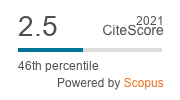GENETIC ALGORITHM-BASED PROPORTIONAL DERIVATIVE CONTROLLER FOR THE DEVELOPMENT OF ACTIVE SUSPENSION SYSTEM
Abstract
Suspension system design plays an important role in improving passenger ride comfort. Traditionally automotive suspension designs have been a compromise between the three conflicting criteria of passenger comfort, suspension travel and road holding ability. Demands for better ride comfort and controllability of road vehicles like passenger cars have motivated to develop new type of suspension systems like active suspension. Ride comfort is directly related to the acceleration sensed by passengers when traveling on a rough road. Road holding ability is associated with the contact forces of the tires and the road surface. These contact forces are assumed to depend linearly on the tire deflection. Suspension travel refers to the relative displacement between the sprung and the unsprung masses. The present work aims at developing an active suspension for the quarter car model of a passenger car to improve its performance by using a proportional derivative (PD) controller in a closed loop circuit with suspension travel as feedback. In PD controller the proportional term provides inputs that correct for “current” errors. Derivative term provides “anticipation” of upcoming changes. The controller design deals with the selection of the parameters proportional and derivative gain (Kp, Kd). These gain values have been optimized to minimize the sprung mass acceleration using genetic algorithm with the constraints of suspension travel and tire deflection. To verify the per-formance of active suspension system we simulated the resulting closed loop system for a sinusoidal, step and random road profile using MATLAB and compared the active suspension with passive suspension. The results show that the performance of the active system has improved as both the peak overshoot of sprung mass acceleration, suspension travel and tire deflection have reduced compared to passive system.
Published
Issue
Section
License
Copyright terms are indicated in the Republic of Lithuania Law on Copyright and Related Rights, Articles 4-37.





